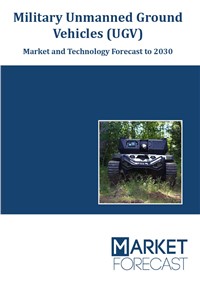Dull and dirty operations that could put human lives at stake are more and more being executed by the unmanned ground vehicles. Rescue operations, firefighting, surveillance, mine clearance, bomb defusal, logistics, and combat missions are amongst the various applications. The development and use of autonomous functions for driving and other non-weapon functions are increasing, but combat functions are restrained by ethical questions. The use of combat applications is expected to grow further after military field testing and doctrine development.
Most small UGVs use battery electric drive systems, where medium and large UGV’s have either Diesel or Hybrid power. Small UGVs largely use tracks and are remote controlled, mainly for local reconnaissance and EOD operations. Large platforms are used for route clearing, demining, engineering, reconnaissance, and flank support in formation for tanks. Some of them are converted manned platforms.
The Global Unmanned Ground Vehicle Market has a market volume of US$ 2.16 billion in 2022 and grows with a CAGR of 17.7% over the forecast period of 2022-2030. North America has the largest market of US$ 0.79 The Asia Pacific region is expected to show the highest market growth with a CAGR of 22.3% over the forecast period. This is owing to the presence of countries like India, China, Japan, South Korea. The increased investment in the military modernization programs in the defense sector, rising use of unmanned ground vehicles for homeland security and commercial applications is another factor that is expected to drive the market in the APAC region.
Covered in this report
- Overview: Snapshot of the Unmanned Ground Vehicles technology in the military market during 2022-2030, including highlights of the demand drivers, trends, and challenges. It also provides a snapshot of the spending with respect to regions as well as segments and sheds light on the emergence of new technologies
- Market Dynamics: Insights into the technological developments in the UGV market and a detailed analysis of the changing preferences of governments around the world. It also analyses changing industry structure trends and the challenges faced by the industry participants.
- Segment Analysis: Insights into the various systems market from a segmental perspective and a detailed analysis of factors influencing the market for each segment.
- Regional Review: Insights into modernization patterns and budgetary allocation for top countries within a region.
- Regional Analysis: Insights into the systems market from a regional perspective and a detailed analysis of factors influencing the market for each region.
- Impact Analysis: Analysis on how certain events will impact the UGV market. This will give you an indication on which factors are important for understanding the market.
- Key Program Analysis: Details of the top programs in each segment expected to be executed during the forecast period.
- Competitive landscape Analysis: Analysis of competitive landscape of this industry. It provides an overview of key companies, together with insights such as key alliances, strategic initiatives, and a brief financial analysis
Segmentation
This report is segmented by Region, User, Application, Platform, Size, and Power Source.Region
- North America
- Europe
- APAC
- Middle East
- RoW
- Defense
- Homeland Security
- Logistics
- Surveillance
- Attack
- Bomb Defusal
- Others
- Small
- Medium
- Large
- Battery-Electric
- Diesel-Electric
- Other
Reasons to buy
- Determine prospective investment areas based on a detailed trend analysis of the global unmanned ground vehicles industry over the next eight years.
- Gain in-depth understanding about the underlying factors driving demand for different application segments in the top spending countries across the world and identify the opportunities offered by each of them.
- Strengthen your understanding of the market in terms of demand drivers, industry trends, and the latest technological developments, among others.
- Identify the major channels that are driving the global unmanned ground vehicles business, providing a clear picture about future opportunities that can be tapped, resulting in revenue expansion.
- Channelise resources by focusing on the ongoing programs that are being undertaken by the ministries of different countries within the unmanned cargo aircraft market.
- Make correct business decisions based on thorough analysis of the total competitive landscape of the sector with detailed profiles of the top platform providers around the world which include information about their products, alliances, recent contract wins and financial analysis wherever available.




